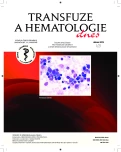Invasive fungal infections following autologous hematopoietic stem cell transplantation in patients with multiple myeloma
Authors:
J. Gabzdilová; E. Tóthová 1; T. Guman 2; Š. Raffač 1; P. Jarčuška 3 4
Authors‘ workplace:
Klinika hematológie a onkohematológie UNLP a LF UPJŠ, Košice
1; Ústav lekárskej a klinickej biofyziky LF UPJŠ, Košice
2; Oddelenie laboratórnej medicíny UNLP, Košice
3; Klinika infektológie a cestovnej medicíny UNLP a LF UPJŠ, Košice
4
Published in:
Transfuze Hematol. dnes,21, 2015, No. 1, p. 24-29.
Category:
Comprehensive Reports, Original Papers, Case Reports
Overview
The article gives a history of the occurrence of invasive fungal infections in patients with multiple myeloma following autologous stem cell transplantation. These patients are at low risk (LR) for developing invasive fungal infection (IFI). It assesses the impact of previous treatment of the underlying disease; comorbidities and risk factors for the incidence and aetiology of invasive fungal infections; their clinical manifestation and treatment. In the analysed group of 39 patients, invasive fungal infection developed in 4 patients. In 2 cases, possible invasive fungal infection of the lungs was diagnosed One patient was diagnosed with probable invasive aspergillosis of the lungs and the other case suggested the possibility of lung infection caused by Trichosporon species. Risks associated with the development of these infectious complications included the administration of corticosteroids, neutropenia, mucositis and renal insufficiency.
Key words:
multiple myeloma, invasive fungal infections, risk factors, autologous hematopoietic stem cell transplantation
Sources
1. Upton A, Kirby KA, Carpenter P, et al. Invasive aspergillosis following hematopoietic cell transplantion: Outcomes and prognostic factors associated with mortality. Clin Infect Dis 2007; 44: 531–540.
2. Pagano L, Morena C, Candoni A, et al. The epidemiology of fungal infections in patients with hematologic malignancies: the SEIFEM-2004 study. Haematologica 2006; 91: 1068–1075.
3. Marr K A, Carter RA, Crippa F, et al. Epidemiology and outcome of mould infections in hematopoetic stem cell transplant recipients. Clin Infect Dis 2002; 34: 909–917.
4. De Naurois I, Basso MJ, Marti F, et al. Management of febrile neutropenia: ESMO Clinical Practice Guidelines. Ann Oncol 2010; 21(suppl 5): v252–v256.
5. Lalla RV, Sonis ST, Peterson DE. Management of oral mucositis in patients with cancer. Dent Clin N Am 2008; 5: 61–77.
6. Ráčil Z, Haber J, Drgoňa Ľ, et al. Empirická antimykotická léčba febrilní neutropenie u nemocných s hematologickou malignitou – doporučení odborníků – s podporou CELL, ČHS ČLS JEP, ČOS ČLS JEP, SCHS SLS. Postgrad Med 2010; 12: 23–25.
7. Freifeld AG, Bow EJ, Sepkowitz KA, et al. Clinical practice guideline for the use of antimicrobial agents in neutropenic patients with cancer: 2010 update by the Infectious Diseases Society of America. Clin Infect Dis 2011; 52: 56–90.
8. De Pauw B, Walsh TJ, Donnelly JP, et al. Revised definitions of invasive fungal diseases from the European Organization for Reasearch and Treatment of Cancer / Invasive Fungal Infections Cooperative Group and the National Institute of Allergy and Infectious Diseases Mycoses Study Group (EORTC/MSG) Consensus. Clin Infect Dis 2008; 46(12): 1813–1821.
9. Segal BH, Herbrecht R, Stevenns DA, et al. Defining response to therapy and study outcomes in clinical trials of invasive fungal diseases: Mycoses Study Group and European Organization for Research and Treatment of Cancer consensus criteria. Clin Infect Dis 2008; 47(5): 674–683.
10. Nucci M, Anaissie E. Infections in patients with multiple myeloma in the era of high-dose therapy and novel agents. Clin Infect Dis 2009; 49: 1211–1225.
11. Post MJ, Lass-Floerl C, Gastl G, Nachbaur D. Invasive fungal infections in allogeneic and autologous stem cell transplant recipients: a single-center study of 166 transplanted patients. Transpl Infect Dis 2007; 9: 189–195.
12. Schütt P, Brandhorst D, Stellberg W, et al. Immune parameters in multiple myeloma patients: influence of treatment and correlation with opportunistic infections. Leuk Lymphoma 2006; 47(8): 1570–1582.
13. Gill L, Kozlowska-Skrzypczak M, Mol A, et al. Increased risk for invasive aspergillosis in patients with lymphoproliferative diseases after autologous hematopoietic SCT. Bone Marrow Transplant 2009; 43: 121–126.
14. Cornillet A, Camus A, Nimubona S, et al. Comparison of epidemiological, clinical and biological features of invasive aspergillosis in neutropenic and nonneutropenic patients: a 6-year survey. Clin Infect Dis 2006; 43(5): 577–584.
15. Nucci M, Nouér SA, Anaissia E. Early diagnosis of invasive pulmonary aspergillosis in hematologic patients: an opportunity to improve the outcome. Haematologica 2013; 98(11): 1657–1660.
16. Nosari AM, Pioltelli ML, Riva M, et al. Invasive fungal infections in lymphoproliferative disorders: a monocentric retrospective experience. Leuk Lymphoma 2014; 55: 1844–1848.
Labels
Haematology Internal medicine Clinical oncologyArticle was published in
Transfusion and Haematology Today

2015 Issue 1
- Neutralizing Antibodies Against Emicizumab – Detailed Analysis Based on a Case Study
- Position of aPCC in the Treatment of Hemophilia A Complicated by the Development of Inhibitors
- Sport and Physical Activity Benefit Hemophiliacs
- What FVIII Levels Are Ideal for Preventing Bleeding in Hemophilia A?
- Administration of aPCC as a Prevention of Bleeding After Major Cardiac Surgical Procedures
Most read in this issue
- Infectious complications of induction therapy in acute myeloid leukaemia patients without the use of antibiotic prophylaxis
- Interference of blood plasma components in turbidimetric D-dimer estimation
- Invasive fungal infections following autologous hematopoietic stem cell transplantation in patients with multiple myeloma
- Engraftment of acute and chronic myeloid leukemia in NOD scid gamma mice
